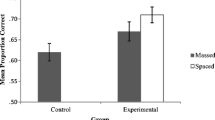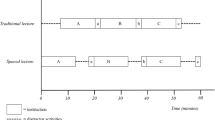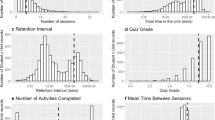Abstract
Every day, students and instructors are faced with the decision of when to study information. The timing of study, and how it affects memory retention, has been explored for many years in research on human learning. This research has shown that performance on final tests of learning is improved if multiple study sessions are separated—i.e., “spaced” apart—in time rather than massed in immediate succession. In this article, we review research findings of the types of learning that benefit from spaced study, demonstrations of these benefits in educational settings, and recent research on the time intervals during which spaced study should occur in order to maximize memory retention. We conclude with a list of recommendations on how spacing might be incorporated into everyday instruction.



Similar content being viewed by others
References
Bahrick, H. P. (1979). Maintenance of knowledge: questions about memory we forget to ask. Journal of Experimental Psychology: General, 108, 296–308.
Bahrick, H. P., & Phelps, E. (1987). Retention of Spanish vocabulary over eight years. Journal of Experimental Psychology: Learning, Memory, and Cognition, 13, 344–349.
Bahrick, H. P., Bahrick, L. E., Bahrick, A. S., & Bahrick, P. E. (1993). Maintenance of foreign language vocabulary and the spacing effect. Psychological Science, 4, 316–321.
Balota, D. A., Duchek, J. M., & Logan, J. M. (2007). Is expanded retrieval practice a superior form of spaced retrieval? A critical review of the extent literature. In J. S. Nairne (Ed.), The foundations of remembering: essays in honor of Henry L. Roediger III (pp. 83–105). London: Psychology Press.
Berger, S. A., Hall, L. K., & Bahrick, H. P. (2008). Stabilizing access to marginal and submarginal knowledge. Journal of Experimental Psychology: Applied, 5, 438–447.
Bird, S. (2010). Effects of distributed practice on the acquisition of second language English syntax. Applied PsychoLinguistics, 31, 635–650.
Bjork, R. A. (1979). Information-processing analysis of college teaching. Educational Psychologist, 14, 15–23.
Bloom, K. C., & Shuell, T. J. (1981). Effects of massed and distributed practice on the learning and retention of second-language vocabulary. Journal of Educational Research, 74, 245–248.
Carpenter, S. K., & DeLosh, E. L. (2005). Application of the testing and spacing effects to name-learning. Applied Cognitive Psychology, 19, 619–636.
Carpenter, S. K., Pashler, H., Wixted, J. T., & Vul, E. (2008). The effects of tests on learning and forgetting. Memory and Cognition, 36, 438–448.
Carpenter, S. K., Pashler, H., & Cepeda, N. J. (2009). Using tests to enhance 8th grade students’ retention of US history facts. Applied Cognitive Psychology, 23, 760–771.
Cepeda, N. J., Pashler, H., Vul, E., Wixted, J. T., & Rohrer, D. (2006). Distributed practice in verbal recall tasks: a review and quantitative synthesis. Psychological Bulletin, 132, 354–380.
Cepeda, N. J., Vul, E., Rohrer, D., Wixted, J. T., & Pashler, H. (2008). Spacing effects in learning: a temporal ridgeline of optimal retention. Psychological Science, 19, 1095–1102.
Cepeda, N. J., Coburn, N., Rohrer, D., Wixted, J. T., Mozer, M. C., & Pashler, H. (2009). Optimizing distributed practice: theoretical analysis and practical implications. Experimental Psychology, 56, 236–246.
Cull, W. L. (2000). Untangling the benefits of multiple study opportunities and repeated testing for cued recall. Applied Cognitive Psychology, 14, 215–235.
Cull, W. L., Shaughnessy, J. J., & Zechmeister, E. B. (1996). Expanding the understanding of the expanding-pattern-of-retrieval mnemonic: toward confidence in applicability. Journal of Experimental Psychology: Applied, 2, 365–378.
Dempster, F. N. (1987). Time and the production of classroom learning: discerning implications from basic research. Educational Psychologist, 22, 1–21.
Dempster, F. N. (1988). The spacing effect: a case study in the failure to apply the results of psychological research. American Psychologist, 43, 627–634.
Dempster, F. N. (1989). Spacing effects and their implications for theory and practice. Educational Psychology Review, 1, 309–330.
Dillon, S. (2008). Survey finds teenagers ignorant on basic history and literature questions. The New York Times, A16.
Donovan, J. J., & Radosevich, D. J. (1999). A meta-analytic review of the distribution of practice effect: now you see it, now you don't. Journal of Applied Psychology, 84, 795–805.
Ebbinghaus, H. (1885/1913). Memory (H. A. Ruger & C. E. Bussenius, Transl.). New York: Teachers College, Columbia University.
Fishman, E. J., Keller, L., & Atkinson, R. C. (1968). Massed versus distributed practice in computerized spelling. Journal of Educational Psychology, 59, 290–296.
Glenberg, A. M. (1976). Monotonic and nonmonotonic lag effects in paired-associate and recognition memory paradigms. Journal of Verbal Learning and Verbal Behavior, 15, 1–16.
Halpern, D. F. (2008, March). 25 learning principles to guide pedagogy and the design of learning environments. Paper distributed at the keynote address at the Bowling Green State University Teaching and Learning Fair. Bowling Green, OH
Hintzman, D. L. (1969). Recognition time: effects of recency, frequency, and the spacing of repetitions. Journal of Experimental Psychology, 79, 192–194.
Hintzman, D. L. (1974). Theoretical implications of the spacing effect. In R. L. Solso (Ed.), Theories in cognitive psychology: The Loyola symposium (pp. 77–97). Potomac: Erlbaum.
Jones, H. E. (1923). Experimental studies of college teaching. Archives of Psychology, 68, 1–71.
Kahana, M. J., & Howard, M. W. (2005). Spacing and lag effects in free recall of pure lists. Psychonomic Bulletin & Review, 12, 159–164.
Karpicke, J. D., & Roediger, H. L., III (2007). Expanding retrieval practice promotes short-term retention, but equally spaced retrieval enhances long-term retention. Journal of Experimental Psychology: Learning, Memory, and Cognition, 33, 704–719.
Landauer, T. K., & Bjork, R. A. (1978). Optimum rehearsal patterns and name learning. In M. M. Gruneberg, P. E. Morris, & R. N. Sykes (Eds.), Practical aspects of memory (pp. 625–632). London: Academic Press.
Logan, J. M., & Balota, D. A. (2008). Expanded vs. equal interval spaced retrieval practice: exploring different schedules of spacing and retention interval in younger and older adults. Aging, Neuropsychology, & Cognition, 15, 257–280.
Melton, A. W. (1970). The situation with respect to the spacing of repetitions and memory. Journal of Verbal Learning & Verbal Behavior, 9, 596–606.
Metcalfe, J., Kornell, N., & Son, L. K. (2007). A cognitive-science based programme to enhance study efficacy in a high and low risk setting. European Journal of Cognitive Psychology, 19, 743–768.
Moulton, C.-A. E., Dubrowski, A., MacRae, H., Graham, B., Grober, E., & Reznick, R. (2006). Teaching surgical skills: what kind of practice makes perfect? A randomized, controlled trial. Annals of Surgery, 244, 400–409.
Nelson, T. O. (1985). Ebbinghaus’s contribution to the measurement of retention: savings during relearning. Journal of Experimental Psychology: Learning, Memory, and Cognition, 11, 472–479.
Pashler, H., Bain, P., Bottge, B., Graesser, A., Koedinger, K., McDaniel, M., & Metcalfe, J. (2007). Organizing Instruction and Study to Improve Student Learning (NCER 2007-2004). Washington, DC: National Center for Education Research, Institute of Education Sciences, U. S. Department of Education. Retrieved from http://ncer.ed.gov
Pashler, H., Rohrer, D., Cepeda, N. J., & Carpenter, S. K. (2007). Enhancing learning and retarding forgetting: choices and consequences. Psychonomic Bulletin & Review, 14, 187–193.
Pyc, M. A., & Rawson, K. (2007). Examining the efficiency of schedules of distributed retrieval practice. Memory and Cognition, 35, 1917–1927.
Rea, C. P., & Modigliani, V. (1985). The effect of expanded versus massed practice on the retention of multiplication facts and spelling lists. Human Learning: Journal of Practical Research & Applications, 4, 11–18.
Rea, C. P., & Modigliani, V. (1987). The spacing effect in 4- to 9-year-old children. Memory and Cognition, 15, 436–443.
Reynolds, J. H., & Glaser, R. (1964). Effects of repetition and spaced review upon retention of a complex learning task. Journal of Educational Psychology, 55, 297–308.
Rohrer, D. (2009). The effects of spacing and mixing practice problems. Journal for Research in Mathematics Education, 40, 4–17.
Rohrer, D., & Pashler, H. (2010). Recent research on human learning challenges conventional instructional strategies. Educational Researcher, 39, 406–412.
Rohrer, D., & Taylor, K. (2006). The effects of overlearning and distributed practice on the retention of mathematics knowledge. Applied Cognitive Psychology, 20, 1209–1224.
Rohrer, D., & Taylor, K. (2007). The shuffling of mathematics practice problems boosts learning. Instructional Science, 35, 481–498.
Seabrook, R., Brown, G. D. A., & Solity, J. E. (2005). Distributed and massed practice: from laboratory to classroom. Applied Cognitive Psychology, 19, 107–122.
Sobel, H. S., Cepeda, N. J., & Kapler, I. V. (2011). Spacing effects in real-world classroom vocabulary learning. Applied Cognitive Psychology, 25, 763–767.
Taylor, K., & Rohrer, D. (2010). The effect of interleaving practice. Applied Cognitive Psychology, 24, 837–848.
Tiedeman, H. R. (1948). A study in retention of classroom learning. The Journal of Educational Research, 41, 516–531.
Toppino, T. C. (1991). The spacing effect in young children’s free recall: support for automatic process explanations. Memory and Cognition, 19, 159–167.
Toppino, T. C., & DeMesquita, M. (1984). Effects of spacing repetitions on children’s memory. Journal of Experimental Child Psychology, 37, 637–648.
Toppino, T. C., & DiGeorge, W. (1984). The spacing effect in free recall emerges with development. Memory and Cognition, 12, 118–122.
Verkoeijen, P. P. J. L., Rikers, R. M. J. P., & Özsoy, B. (2008). Distributed rereading can hurt the spacing effect in text memory. Applied Cognitive Psychology, 22, 685–695.
Willingham, D. T. (2002). Allocating student study time: massed vs. distributed practice. American Educator, 47, 37–39.
Acknowledgments
This work was supported by a collaborative activity award from the James S. McDonnell Foundation, by the Office of Naval Research (grant N00014-10-1-0072), by the Institute of Education Sciences (US Department of Education grant R305B070537 to H. Pashler and grant R305A110517 to D. Rohrer), and by the National Science Foundation (Center Grant SBE-0542013).
Author information
Authors and Affiliations
Corresponding author
Rights and permissions
About this article
Cite this article
Carpenter, S.K., Cepeda, N.J., Rohrer, D. et al. Using Spacing to Enhance Diverse Forms of Learning: Review of Recent Research and Implications for Instruction. Educ Psychol Rev 24, 369–378 (2012). https://doi.org/10.1007/s10648-012-9205-z
Published:
Issue Date:
DOI: https://doi.org/10.1007/s10648-012-9205-z




